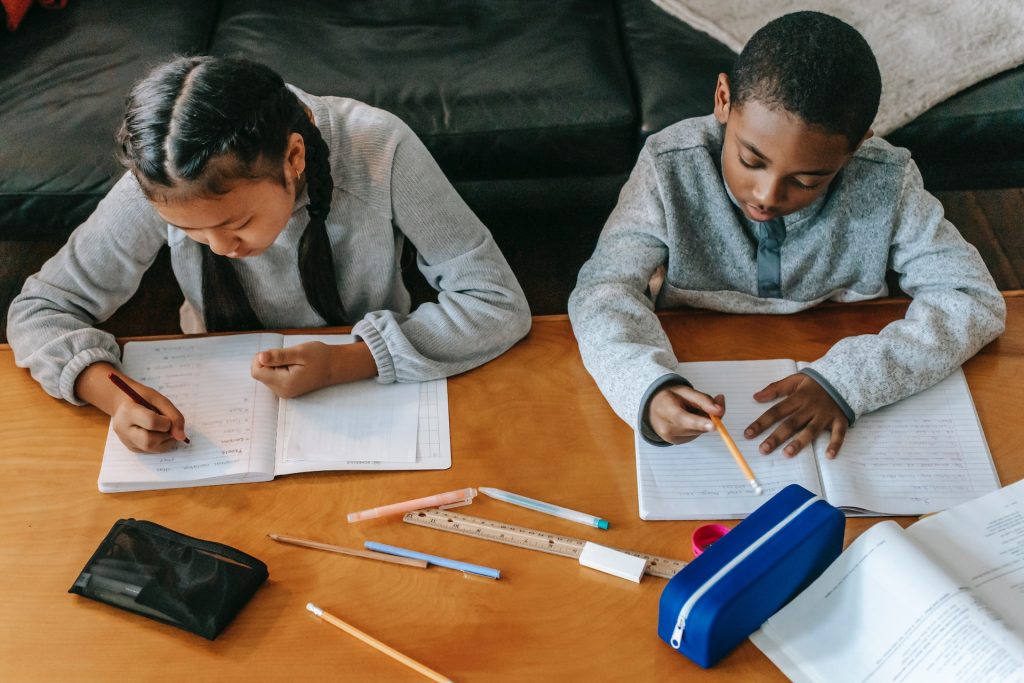Discover effective strategies and techniques for teaching writing to 8-9 year old children.
How to Teach Writing to 8-9 Year Old Children
Writing is an essential skill that children should develop at an early age. For 8-9 year olds, this is a critical time to hone their writing abilities and lay a strong foundation for their future. In this article, we will explore effective strategies and techniques to help you teach writing to children in this age group. So, put on your teacher hats and let’s dive into the wonderful world of writing!
Understanding the Writing Skills of 8-9 Year Olds

Before we embark on our teaching journey, it is important to understand the unique characteristics of 8-9 year olds’ writing abilities. At this age, children are experiencing significant cognitive development, which impacts their writing skills.
One important aspect to consider is their cognitive development and its connection to writing ability. As their thinking becomes more concrete, children in this age group are eager to express their thoughts and ideas through writing. They begin to understand the basic rules of grammar and punctuation, although they may still make errors.
In addition to cognitive development, there are common writing challenges that 8-9 year olds face. These challenges include spelling difficulties, limited vocabulary, and struggles with sentence structure. Understanding these challenges will help us tailor our teaching methods to address them effectively.
Spelling difficulties are a common hurdle for 8-9 year olds when it comes to writing. At this stage, they are still developing their phonetic awareness and may struggle with spelling words correctly. It is important to provide them with strategies to improve their spelling, such as breaking words down into syllables or using mnemonic devices.
Another challenge that 8-9 year olds face is limited vocabulary. While they have acquired a substantial amount of words by this age, their vocabulary is still expanding. They may find it challenging to find the right words to express their thoughts and ideas. Encouraging them to read extensively and exposing them to a variety of texts can help broaden their vocabulary and improve their writing skills.
Sentence structure is yet another area where 8-9 year olds may struggle. They may have difficulty constructing complex sentences or using appropriate punctuation. Teaching them the different types of sentences, such as declarative, interrogative, imperative, and exclamatory, can help them understand sentence structure better. Additionally, providing them with opportunities to practice writing different types of sentences and incorporating punctuation marks will enhance their writing abilities.
It is important to note that while 8-9 year olds may face these challenges, they also possess unique strengths in their writing abilities. They are often imaginative and creative, coming up with unique ideas and storylines. Encouraging their creativity and providing them with opportunities to express themselves through writing can foster their love for writing and help them overcome any challenges they may face.
In conclusion, understanding the writing skills of 8-9 year olds involves recognizing their cognitive development, as well as the common challenges they face, such as spelling difficulties, limited vocabulary, and struggles with sentence structure. By addressing these challenges and nurturing their creative abilities, we can support their growth as writers and help them develop strong writing skills.
Preparing the Environment for Writing
Creating a conducive writing space is crucial to encourage children to enjoy the writing process. Designate a specific area in your home or classroom where they can focus and have easy access to writing materials.
When setting up the writing space, consider the lighting. Natural light is ideal as it helps create a bright and inviting atmosphere. Position the writing area near a window, allowing the child to benefit from the natural light while writing.
In addition to natural light, it’s important to have a comfortable seating arrangement. Provide a chair and desk or table that is appropriate for the child’s age and size. A chair with proper back support and a desk or table at the right height will help the child maintain good posture while writing.
Creating a quiet and calm environment is also essential for effective writing. Minimize distractions by keeping the writing area away from noisy areas or electronic devices. Consider using soft background music or white noise to help create a peaceful atmosphere that fosters concentration.
It’s important to provide essential writing tools for children, such as age-appropriate pencils, erasers, and notebooks. Make writing materials easily accessible, so children can independently choose and use them whenever inspiration strikes.
Consider organizing the writing materials in a way that is visually appealing and encourages creativity. Use colorful containers or trays to hold the pencils, erasers, and other writing tools. Label each container with the name of the item to promote organization and help children develop a sense of responsibility for their writing materials.
Encourage children to personalize their writing space by allowing them to decorate it with their favorite artwork or motivational quotes. This will help create a sense of ownership and pride in their writing area.
Incorporating nature elements into the writing space can also enhance the writing experience. Place a small potted plant or a vase with fresh flowers on the desk to bring a touch of nature indoors. Studies have shown that being in the presence of nature can improve focus and creativity, making it an excellent addition to the writing environment.
Lastly, consider providing a variety of writing materials to cater to different preferences and learning styles. Some children may prefer using markers or colored pencils, while others may enjoy writing with gel pens or fountain pens. By offering a range of options, you can help children find the writing tools that they feel most comfortable and confident using.
Techniques to Encourage Writing
Let’s face it, writing can sometimes seem like a daunting task for young children. But with the right techniques, we can make writing an enjoyable and engaging activity for them.
One way to make writing fun is by incorporating games and activities into the process. For example, you can play word association games or writing prompts where children have to create a story using specific words. These activities not only spark their creativity but also build their vocabulary and sentence structure skills.
Incorporating writing into daily activities is another effective technique. Encourage children to write grocery lists, letters to family members, or even short stories about their favorite characters. By integrating writing into their everyday lives, children will see it as a natural and meaningful part of their routine.
Furthermore, providing children with a variety of writing materials can enhance their writing experience. Offer them colorful pens, markers, and different types of paper to make the process more visually appealing. This not only adds excitement to writing but also allows children to experiment with different writing tools and mediums.
Another technique that can encourage writing is creating a supportive and non-judgmental environment. Encourage children to express their thoughts and ideas freely without fear of criticism. By fostering a safe space for writing, children will feel more confident and motivated to explore their creativity through words.
Additionally, setting aside dedicated writing time can help children develop a writing habit. Designate a specific time each day for writing activities, whether it’s in school or at home. Consistency is key, as it helps children establish a routine and develop a sense of discipline when it comes to writing.
Moreover, providing children with writing prompts or topics of interest can ignite their imagination and make the writing process more enjoyable. Ask them to write about their favorite hobbies, dream vacations, or even imaginary worlds. By giving them a starting point, children can focus their energy on expanding their ideas and developing their writing skills.
Furthermore, encouraging children to share their writing with others can boost their confidence and motivation. Create opportunities for them to read their stories aloud to classmates, family members, or even at local community events. This not only helps children develop their public speaking skills but also allows them to receive feedback and recognition for their writing efforts.
In conclusion, by incorporating games and activities, integrating writing into daily life, providing a variety of writing materials, creating a supportive environment, setting aside dedicated writing time, offering writing prompts, and encouraging sharing, we can make writing a fun and rewarding experience for young children.
Teaching Writing Basics

Now, let’s dive into the nitty-gritty of teaching writing basics to 8-9 year olds. Oouch! Punctuation and grammar might sound intimidating, but fear not, we’re here to make it fun and engaging.
When introducing grammar and punctuation, make it a playful and interactive experience. Use silly examples or create funny stories that illustrate the concept you want to teach. For example, you can tell a story about a mischievous comma that loves to jump around and play hide-and-seek in sentences. The children can then try to find the comma’s hiding spots and place it in the correct position. This not only helps them understand the importance of punctuation but also makes the learning process enjoyable.
Incorporate games like punctuation races or grammar treasure hunts to keep children engaged while they learn. In a punctuation race, divide the class into teams and provide each team with a sentence that lacks proper punctuation. The teams then compete to see who can correctly punctuate the sentence first. This activity not only encourages teamwork but also reinforces the importance of using punctuation marks accurately.
Building vocabulary and sentence structure can be done through exciting activities like word hunts and sentence building games. For a word hunt, give each child a list of words related to a specific topic, such as animals or sports. The children then have to find those words in books or other written materials. This activity not only helps expand their vocabulary but also encourages them to explore different types of texts.
To practice crafting interesting sentences, encourage children to read books and keep a journal. Reading exposes them to a variety of sentence structures and writing styles, while journaling allows them to express their thoughts and ideas in their own words. You can also introduce sentence building games, where children take turns adding words to create a collaborative story. This activity not only enhances their sentence structure skills but also sparks their creativity.
Remember, teaching writing basics should be a dynamic and engaging process. By incorporating playful activities and providing opportunities for exploration and creativity, you can make learning grammar, punctuation, vocabulary, and sentence structure an enjoyable adventure for 8-9 year olds.
Guiding Children in Creative Writing
Children in this age group have vivid imaginations and love to share stories. Use this creativity to guide them in creative writing.
Encourage imagination and storytelling by providing open-ended prompts. Prompt them to write about their dream adventures or create imaginative characters. Allow them to explore different genres, such as fantasy, science fiction, or mystery, so they can unleash their creativity to the fullest.
Teaching the elements of a story, such as a captivating beginning, an exciting middle, and a satisfying ending, will help children structure their narratives effectively. Guide them in developing characters, setting, and conflict to create compelling stories that will hook their readers.
In conclusion, teaching writing to 8-9 year old children is a rewarding and exciting endeavor. By understanding their abilities, creating a conducive environment, incorporating fun techniques, and guiding them in creative writing, we can ignite their passion for writing while nurturing their skills. So, let’s spark their imaginations and watch them flourish as confident young writers!



